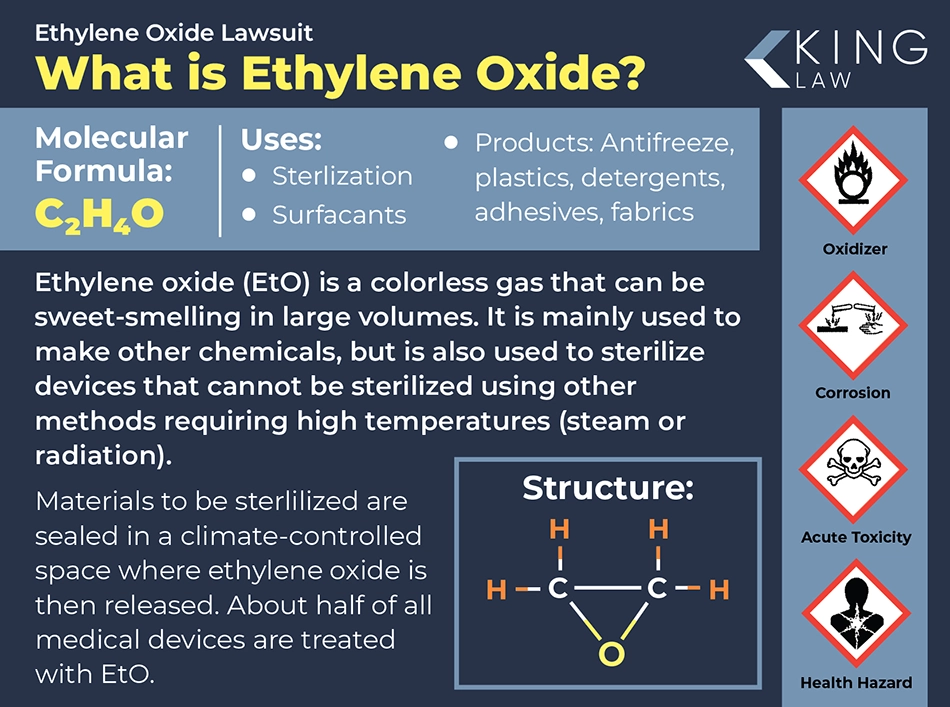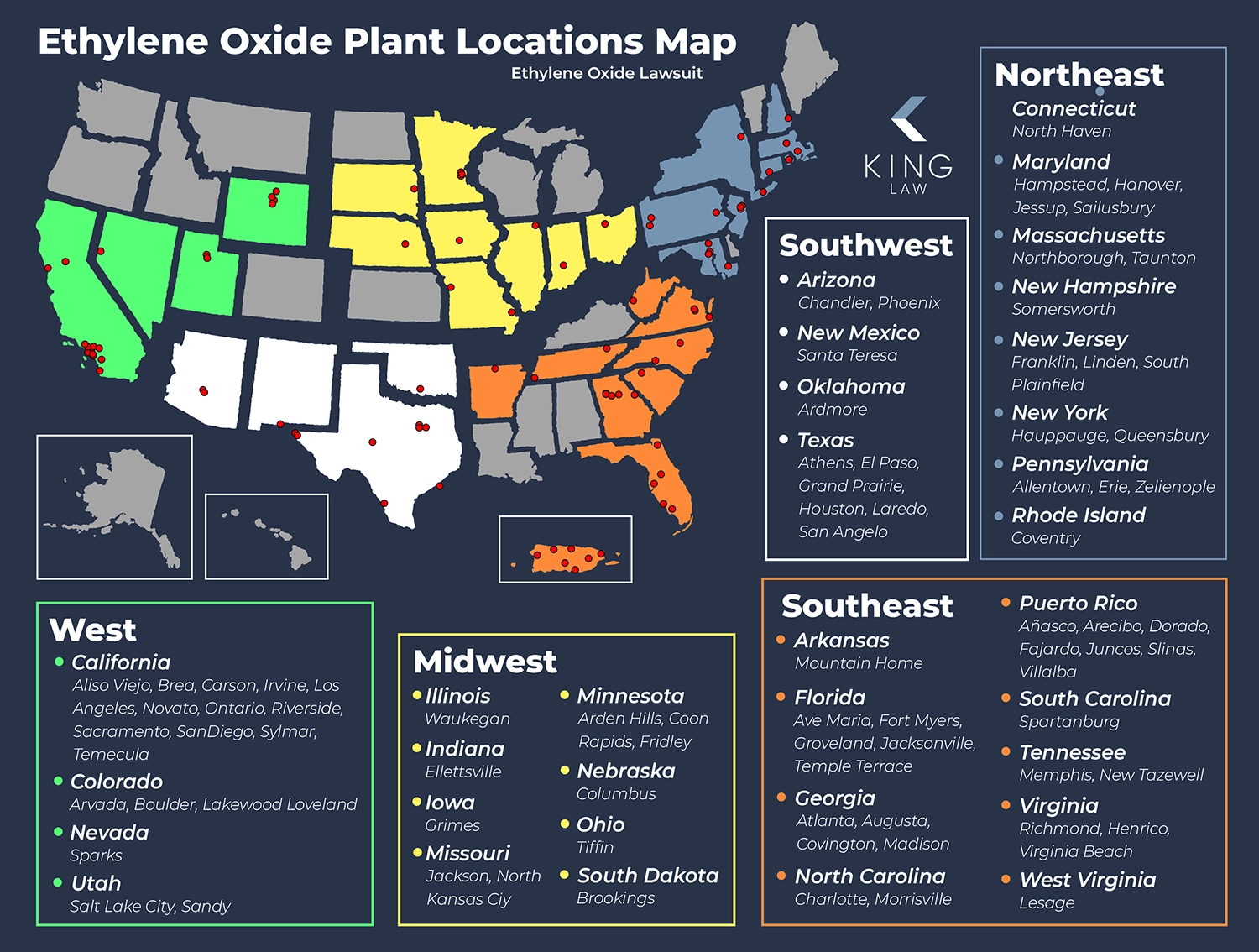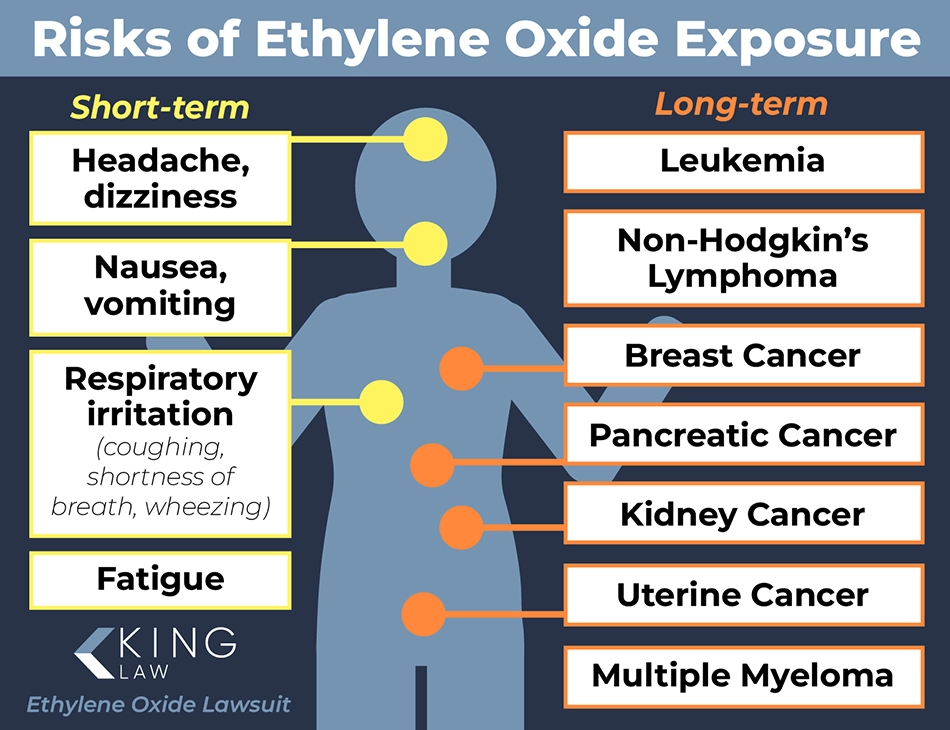
Many people have been exposed to ethylene oxide (EtO) because they live in a community where the gas was released into the air. Unfortunately, many of those exposed to EtO have developed cancer. In turn, these people are filing lawsuits. These lawsuits say chemical makers and plant owners knew ethylene oxide caused cancer, yet they continued to put people at risk.
Victims and their surviving loved ones are suing because they developed leukemia, non-Hodgkin’s lymphoma, multiple myeloma, or breast cancer due to ethylene oxide exposure. These lawsuits are being filed against the companies that released ethylene oxide into the air and did not warn or try to protect residents.
In this article, you can find detailed information about what ethylene oxide is and the types of cancers it can cause. This page also contains guidance on who may qualify for compensation from an ethylene oxide lawsuit and how they can join the lawsuit against ethylene oxide manufacturers.
Ethylene Oxide Lawsuit News and Updates
July 2, 2025: Willowbrook High School Teachers Sued Sterigenics Due to Suspected Ethylene Oxide-Cancer Link
Six former teachers from Willowbrook High School have developed cancer, and they believe the ethylene oxide pollution from the nearby Sterigenics plant is the cause. These teachers worked at the high school for many years and were unknowingly exposed to ethylene oxide in the air they breathed during their time as teachers. They have sued Sterigenics to gain compensation and protect the public from this carcinogenic gas.
June 17, 2025: Steris Corporation Reaches $48 Million Settlement For Lawsuits Related to Its Ethylene Oxide Plant
The Steris Corporation has reached a settlement deal regarding lawsuits filed over Ethylene oxide exposure. The lawsuits are related to a medical-device-sterilization plant in Waukegan, Illinois, that Steris operated from 2005 to 2008. Steris did not say how many lawsuits this settlement will cover when it filed government documentation disclosing the settlement. Although the company announced this proposed settlement in March, it still needs to be approved by the United States Securities and Exchange Commission. Steris is accused of endangering the welfare of residents by releasing EtO into nearby communities.
May 6, 2025: Georgia Man Awarded $20 Million in Ethylene Oxide Lawsuit
A jury in Gwinnett County Georgia has awarded a retired truck driver $20 million in a lawsuit he filed against C.R. Bard. Bard owned an ethylene oxide (EtO) sterilization plant in Covington, Georgia. After 47 years of driving deliveries for the plant, Walker developed non-Hodgkin’s lymphoma. Walker sued Bard, saying exposure to EtO caused his cancer. Walker was also awarded $50 million in punitive damages, but a mistrial was declared in that portion of the trial. At the second trial, Walker may be awarded additional compensation. Since 1967, the Covington plant has used more than 9.7 million pounds of ethylene oxide. However, emissions controls were only installed starting in the 1990s, but thousands of area residents are still at risk of developing cancer.
January 10, 2023: Sterigenics Agrees to Pay $408 Million to Settle 870 Ethylene Oxide Lawsuits
Sterigenics, who runs plants that sterilize medical devices with ethylene oxide, has announced a settlement related to a plant in Willowbrook, Illinois. The settlement of 870 lawsuits was announced by Sterigenics’ parent company, Sotera Health. These lawsuits claimed that Sterigenics illegally released ethylene oxide into the air, endangering the health and welfare of thousands of residents in the Willowbrook area.
September 19, 2022: Jury in Chicago Awards $363 Million to Woman Who Says EtO Exposure Caused Her Breast Cancer
A jury in Chicago has ordered Sterigenics to pay a woman in Illinois $363 million, saying that emissions from its medical-device-sterilization factory caused her cancer. At that time, the case was the first to go to court of more than 700 lawsuits Sterigenics is facing. Susan Kamuda’s lawsuit said that Sterigenics had been releasing carcinogenic ethylene oxide into the air for decades, putting thousands of Willowbrook-area residents at risk. Kamuda’s lawsuit said the company was negligent and did not mitigate emissions, despite knowing the dangers of EtO.
About the Ethylene Oxide Lawsuit:
What Is Ethylene Oxide Used For?
Locations of Ethylene Oxide Sterilization Facilities
Ethylene Oxide (EtO) Sterilization Process and Procedure
What Are the Ethylene Oxide Effects on Humans?
Types of Cancer Caused by Ethylene Oxide
Research Linking Cancer to Ethylene Oxide
Who Is Being Sued in the Ethylene Oxide Lawsuit?
Who Qualifies to File an Ethylene Oxide Lawsuit?
How to File an Ethylene Oxide Lawsuit
Deadline to File an Ethylene Oxide Lawsuit
Estimated Ethylene Oxide Lawsuit Settlement Amounts
What Is Ethylene Oxide?
Ethylene oxide (C2H4O) is a human-made industrial solvent. It is a gas that is colorless, slightly sweet-smelling, and highly flammable. Ethylene oxide is used to make a range of consumer goods, including products like antifreeze, detergents, drugs, and polyurethane foams. It is also used to make other chemicals and to sterilize spices and medical equipment. At room temperature, ethylene oxide is a gas, but it turns into a clear liquid at cooler temperatures.
Ethylene oxide is known to be harmful to human health. The Environmental Protection Agency (IARC) classified it as a Group 1 cancer-causing substance. This means that there is sufficient evidence that ethylene oxide causes cancer in humans.
The Chemical Structure of Ethylene Oxide
Ethylene oxide is made of carbon, hydrogen, and oxygen atoms (C2H4O). It is also known as EtO, oxirane, epoxyethane, and by other trade names. It dissolves easily in water and other compounds.
The way the carbon, hydrogen, and oxygen atoms are put together to form ethylene oxide makes it very reactive. Ethylene oxide interacts with the person’s cells, including the proteins and DNA in the cells. Ethylene oxide’s ability to harm a person’s DNA can raise their chances of developing cancer.

What Is Ethylene Oxide Used For?
People use ethylene oxide in many different commercial settings. For example, healthcare facilities and pharmaceutical companies use ethylene oxide to sterilize medical equipment that is sensitive to moisture. About half of all sterile medical equipment in the United States (20 billion pieces of equipment) is treated using ethylene oxide. Ethylene oxide is also part of the process to create antifreeze, plastics, and fabrics. It is also used to treat spices that may carry food-borne pathogens like salmonella and Escherichia coli (E. coli).
The American Chemical Society also describes ethylene oxide as the “workhorse of the cleaning industry,” noting how it is widely used to clean hospitals, restaurants, and public modes of transportation (like buses and trains). Because ethylene oxide is used in so many different settings, many groups of people have been exposed to it and are experiencing higher cancer rates.
Locations of Ethylene Oxide Sterilization Facilities
The infographic below shows the locations of ethylene oxide plants across the United States. These areas may be at risk for cancer clusters due to the toxic nature of EtO emissions.

EPA Warns of Higher Cancer Risks for People Who Live Near Ethylene Oxide Facilities
In 2022, the US EPA issued a special notice to communities, states, Tribes, Territories, and stakeholders located near plants that emit ethylene oxide. The EPA said the intent of the notice was to inform affected people about its “…efforts to address ethylene oxide, a potent air toxic posing serious health risks with long-term exposure.” The EPA has since conducted numerous activities to warn those exposed to ethylene oxide about the chemicals’ dangerous effects and how to mitigate those effects.
Ethylene Oxide (EtO) Sterilization Process and Procedure
The process of using ethylene oxide to sterilize medical equipment begins with placing the materials in a sealed, climate-controlled space. Then, ethylene oxide gas would be released into the space. The ethylene oxide kills the germs (e.g., the bacteria or viruses) on the products. Ethylene oxide does not need to be at high heat to work, unlike many other sterilization methods.
The equipment being sterilized will have a film of ethylene oxide on it at first, so the sterilization team should take steps to remove the gas from the chamber and clear off the residue. However, ethylene oxide can leak out when the team puts equipment into the chamber and removes it. Facilities that are older or that do not have effective ventilation systems are most at risk of having ethylene oxide gas leaks. Many lawsuits are being filed by people who were exposed to ethylene oxide at facilities.
What Are the Ethylene Oxide Effects on Humans?
People who are exposed to ethylene oxide can experience a range of side effects, depending on the frequency and intensity of exposure. Short-term exposure to ethylene oxide can cause nausea, blurred vision, problems breathing, or headaches. Long-term exposure to ethylene oxide can damage someone’s brain or DNA, which may lead to cancer. Ethylene oxide can also cause birth defects if pregnant women are exposed to the chemical.
Even low-level or seemingly “safe” amounts of ethylene oxide can have serious consequences if the person is exposed to ethylene oxide long-term. Not every affected worker or community member will show symptoms right away.
How Ethylene Oxide Emissions Affect Communities
Many communities have been impacted by the release of ethylene oxide into the air. When the gas is used in sterilization procedures, chemical production, or manufacturing, there is leftover (residual) gas. This gas needs to be disposed of. Often, EtO is disposed of through air emissions from factories. The EPA has taken steps to control emissions of ethylene oxide. The EPA and other regulatory agencies across the globe have recognized the dangers of ethylene oxide emissions for surrounding communities. These communities are often subjected to long-term EtO exposure, increasing their risk of cancer.

Types of Cancer Caused by Ethylene Oxide
Ethylene oxide is known to cause many different types of cancer in workers and community members who are exposed to it. For example, ethylene oxide can raise someone’s risk of breast, kidney, pancreatic, and uterine cancer. Ethylene oxide is also associated with non-Hodgkin lymphoma, leukemia, and multiple myeloma. People who developed cancer because they came into contact with ethylene oxide are filing legal claims against the institutions that emitted it into the air.
According to the International Agency on Cancer Research (IARC), ethylene oxide is classified as carcinogenic to humans. This means there is sufficient evidence that ethylene oxide causes cancer.
Non-Hodgkin’s Lymphoma
Scientists have discovered a link between ethylene oxide and non-Hodgkin lymphoma. When someone has non-Hodgkin’s lymphoma the cancer affects their white blood cells (the cells that help their body respond to infections). According to lawsuits filed across the country, people who are exposed to ethylene oxide in the workplace or in their communities may have a greater risk of developing non-Hodgkin lymphoma.
Breast Cancer
Dozens of workers and residents have developed breast cancer because of the ethylene oxide in their environment. A 2023 study found that being exposed to ethylene oxide in the environment increased someone’s chances of early-stage (in situ) breast cancer.
According to studies, women who lived near or worked in a sterilization facility that used ethylene oxide had higher breast cancer rates than others. One Illinois woman won a $363 million verdict against Sterigenics, a sterilization company, because ethylene oxide emitted into the air by her house may have caused her breast cancer.
Leukemia
Ethylene oxide has a well-established connection with leukemia. Ethylene oxide can interrupt how your body creates healthy blood cells in your bone marrow. In 1981, the National Institute for Occupational Safety and Health published a bulletin warning that workers exposed to ethylene oxide were experiencing higher-than-expected rates of chronic lymphatic and mononuclear cell leukemia.
Additionally, a 1986 study reported that intermittent and long-term exposure to even low levels of ethylene oxide increased workers’ chances of leukemia. Since that time, dozens of people who were exposed to ethylene oxide have sued because they got leukemia.
Multiple Myeloma
The CDC reports that ethylene oxide is associated with a higher risk of blood cancers. Multiple myeloma affects plasma cells, a type of white blood cell. Studies have shown that workers with long-term exposure to ethylene oxide had up to a 6-fold increase in myeloma rates. A number of people have sued companies, like Sterigenics, because they believe their myeloma was caused by the ethylene oxide in their environment.
Pancreatic Cancer
Pancreatic cancer is also connected with workplace contact with ethylene oxide; however, this connection has not been studied as much as for other types of cancers. According to a study conducted in 2023, someone’s pancreatic cancer risk can increase the longer someone has worked in a place where ethylene oxide is used. The range the researchers identified as triggering this connection was between 1 and 30 years of workplace contact with ethylene oxide. In recent claims, residents are claiming that the nearby commercial use of ethylene oxide gas has caused their pancreatic cancer.
Kidney Cancer
Ethylene oxide can also impact how someone’s kidneys function. Past research suggests that long-term exposure to this toxic gas can raise someone’s chances of dying of kidney cancer.
Uterine Cancer
Some women who lived near or worked at sterilization sites believe the ethylene oxide gas being used at those facilities led them to develop uterine cancer. Studies have confirmed that ethylene oxide can cause mice to develop uterine cancer. Likewise, a 2016 guidance document published by the EPA about ethylene oxide cautioned that this substance can cause uterine cancer.
Research Linking Cancer to Ethylene Oxide
A number of studies have shown that ethylene oxide causes an increased cancer risk, especially for those who are exposed over a long period of time or in high quantities. For example, the Environmental Protection Agency, the National Institute for Occupational Safety and Health, and the International Agency for Research on Cancer have all classified ethylene oxide as a carcinogen.
Epidemiologic Support For Ethylene Oxide As a Cancer-Causing Agent
Several large-scale studies have looked at whether ethylene oxide can cause cancer. For example, in 2016, the EPA published a groundbreaking report showing that ethylene oxide is a known human carcinogen. According to this report, ethylene oxide can cause tumors and abnormal growths to develop in many parts of the body, including the brain, white blood cells, uterus, lungs, and breasts.
The EPA has also installed several dozen air monitoring devices to track the amount of ethylene oxide in the air. The purpose of this is to identify problematic areas and help reduce the amount of this carcinogen in the environment. The EPA has also updated its guidelines to protect people who are at risk of developing cancer because they are exposed to ethylene gas where they work, live, or go to school.
Who Is Being Sued in the Ethylene Oxide Lawsuit?
People who developed cancer after exposure to ethylene oxide are suing several different companies, including:
- Sterigenics (part of Sotera Health)
- C.R. Bard (part of BD, also known as Becton, Dickinson and Company)
- Steris
- B. Braun
- Midwest Sterilization Corp.
In these lawsuits, victims claim that these companies knew that ethylene oxide emissions were dangerous to human health. Yet, these companies failed to install proper environmental controls or emission scrubbers. Instead, they vented ethylene oxide into a residential community.
People believe these organizations had a duty to tell workers and the surrounding residents about the risks, but the businesses chose not to. Because of this, people who developed cancers connected to EtO believe these companies are liable for their losses.
Ethylene Oxide Lawsuit Settlements
In April of 2025, Sterigenics settled 97 lawsuits and agreed to pay $31 million to people harmed by ethylene oxide emitted by its plant in Willowbrook, Illinois. In a 2023 settlement regarding the same plant, Sterigenics paid $408 million to people who alleged illness due to EtO emissions.
In May of 2022, a jury in Georgia awarded truck driver Gary Walker more than $20 million in compensatory damages. Walker drove a truck to and from a Bard medical equipment sterilization plant in Covington, Georgia, resulting in years of exposure. He was diagnosed with non-Hodgkin’s lymphoma, and the jury agreed C.R. Bard was responsible for his injuries.
Who Qualifies to File an Ethylene Oxide Lawsuit?
People who lived near facilities that used ethylene oxide may qualify for compensation. However, they need to meet the eligibility criteria, which include:
- The person must have lived within four miles of a facility that was emitting ethylene oxide
- They must have resided at that location after the facility opened
- They must have lived in that location for at least one continuous year after the facility opened
People who worked at a facility that used ethylene oxide may be able to seek damages if they also meet the above residency requirements. Workers who do not live within four miles of the plant would have to pursue worker’s compensation cases.
Additionally, the person must have been exposed to ethylene oxide for at least one year before being diagnosed with cancer. They should have an ethylene oxide-related diagnosis, such as:
- Leukemia
- Non-Hodgkin’s lymphoma
- Multiple myeloma
- Breast cancer
There are additional criteria for each cancer type. For example, someone must have developed leukemia after being exposed to ethylene oxide for at least five years. Likewise, someone must be a non-smoker to claim compensation for lung cancer.
If you think you might qualify or are curious if you meet the updated criteria, a personal injury lawyer is a good resource. If you lost a loved one to cancer that may have been caused by ethylene oxide, you may also qualify to file a wrongful death claim.
Check to See if You Live Near an Ethylene Oxide-Emitting Location
Ethylene oxide is used in many factory settings. People may live near a facility that uses this chemical and not be aware of the dangerous emissions these plants cause. To find out if you live near a disinfecting or chemical manufacturing plant that uses ethylene oxide, the Union of Concerned Scientists (UCS) has created an interactive map of the U.S. You can find out if you live near an ethylene oxide plant here.
How to File an Ethylene Oxide Lawsuit
You can file an ethylene oxide lawsuit by following the legal process, which includes the steps outlined below:
- Look for evidence that you lived near a facility that was releasing ethylene oxide into the atmosphere.
- Talk to a lawyer about why you think ethylene oxide caused your cancer.
- Your attorney determines if you are eligible for compensation and requests records on your behalf.
- Your lawyer writes a legal complaint and files it against the company that may have harmed you.
- Your attorney helps you participate in the discovery or fact-gathering process.
- Your attorney tries to reach a settlement with the defendant corporation or prepares your case for trial.
King Law is helping claimants prepare and file lawsuits against negligent corporations that may have released ethylene oxide into the atmosphere and led them to develop cancer.
Deadline to File an Ethylene Oxide Lawsuit
If you believe that ethylene oxide caused your cancer, you must take legal action within a certain amount of time. This filing deadline, called the statute of limitations, is based on the applicable state or federal laws. If you do not file your claim on time, you might not be able to seek compensation. Because of this, it is important to consult a lawyer to learn when your deadlines are and how to meet them. Our team at King Law can help you understand if you are able to file a lawsuit for ethylene oxide exposure.
Estimated Ethylene Oxide Lawsuit Settlement Amounts
Some successful ethylene oxide lawsuit settlements may be up to $175,000 to $500,000 or more. However, the exact amount depends on the factors in that person’s specific situation. For example, someone with a late-stage or aggressive type of cancer may receive a higher settlement. Likewise, someone who was exposed to ethylene oxide at high levels or for a long period of time may also have a stronger case and win a higher settlement. An attorney can help someone estimate the value of their ethylene oxide claim.
Speak With an Ethylene Oxide Lawyer Today
Public reports have shown that, for decades, companies have been pouring ethylene oxide into the atmosphere. Many affected residents believe this has been causing them to develop breast cancer, leukemia, multiple myeloma, and non-Hodgkin lymphoma.
If you developed one of these types of cancer and lived near a facility that may have released ethylene oxide into the environment, you may qualify for a settlement. Get in touch with our intake specialists today by calling (585) 496-2648. King Law offers free case reviews, and we are accepting new ethylene oxide claims. We are here to listen to your concerns and provide answers to your legal questions.

